When you craft with your hands, you're connecting to a rich heritage of makers spanning thousands of years while creating something uniquely yours. You'll discover that making things yourself builds patience, problem-solving skills, and a deeper sense of accomplishment than buying mass-produced items. Through crafting, you can reduce stress, foster mindfulness, and join a supportive community of fellow creators who share your passion. Whether you're interested in pottery, textiles, or other traditional crafts, you're not just making objects – you're crafting a more intentional, fulfilling life. The journey of creation awaits your first step.
Key Takeaways
- Crafting fosters personal growth through patience, problem-solving, and resilience while providing a meaningful alternative to passive consumption.
- Creating handmade items connects us to ancient traditions and cultural heritage passed down through generations.
- Making things by hand promotes mindfulness and mental well-being through focused, present-moment engagement with materials.
- Community crafting builds meaningful relationships and social networks while facilitating knowledge exchange across generations.
- Starting a crafting journey requires basic quality tools, dedicated workspace, and gradual skill development through practice.
Why Making Matters
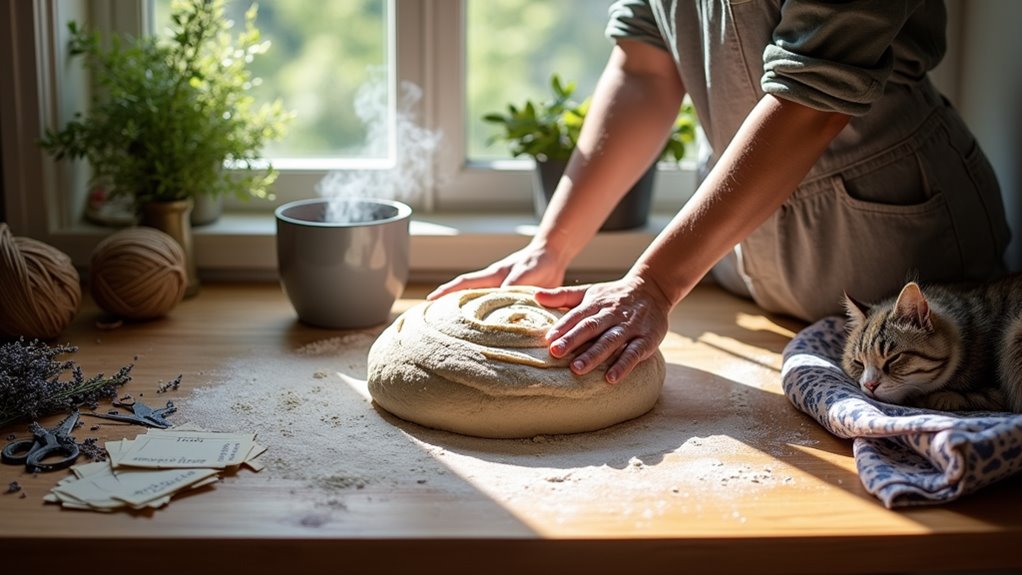
Making things with your own hands connects you deeply to the human experience.
It's a primal act that links you to generations of makers who came before, from ancient pottery artists to medieval blacksmiths to your grandmother knitting sweaters.
When you create something, you're doing more than just producing an object.
You're developing patience, problem-solving skills, and resilience.
Each project teaches you to overcome challenges, learn from mistakes, and trust your instincts.
Whether you're baking bread, building furniture, or tending a garden, the process engages your mind and body in ways that passive consumption never can.
In a world of mass production, making things yourself offers a path to authenticity and self-reliance.
It reminds you that you're capable of more than you think.
The History of Handcrafted Goods
For thousands of years, humans have shaped raw materials into useful and beautiful objects with their hands. From ancient pottery and textiles to intricate metalwork and woodcarving, these crafts have formed the backbone of human civilization.
You'll find evidence of handcrafted goods in every culture, where artisans passed down their skills through generations. Before the Industrial Revolution, nearly everything was handmade – from clothing and furniture to tools and decorative items.
Even as machines began to dominate production in the 18th century, many communities preserved their traditional crafting methods.
Today, you're part of a resurgence in handcrafting, as people seek to reconnect with ancient practices. Whether you're weaving, carving, or creating pottery, you're continuing a legacy that's as old as humanity itself.
Getting Started With Hand Creation
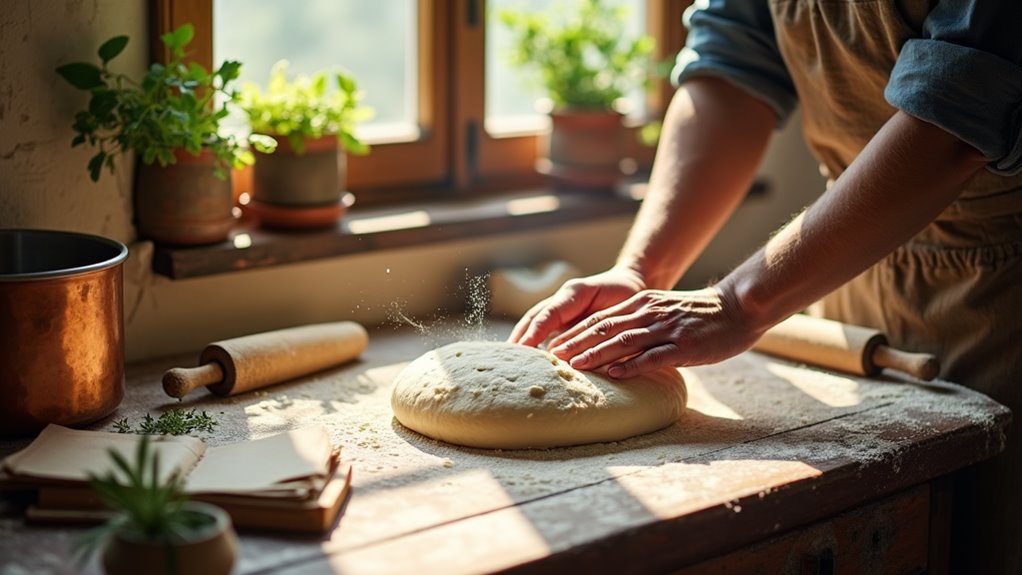
Every handmade journey begins with gathering basic supplies and mastering simple techniques. You'll need a dedicated workspace, whether it's a corner of your kitchen table or a craft room.
Start with quality tools that match your chosen craft – sharp scissors, reliable measuring devices, and proper storage containers are essential foundations.
Choose one craft to focus on initially. You'll learn faster and develop confidence by mastering a single skill before branching out. If you're interested in sewing, begin with straight stitches on scrap fabric.
For knitting, practice the basic knit stitch until it becomes natural. Paper crafters should start with simple folds and cuts before attempting complex designs.
Don't forget to join online communities or local groups where you can learn from experienced crafters and share your progress.
Tools of the Trade
The right tools can transform your handmade projects from frustrating struggles into enjoyable creative sessions. You'll need quality scissors, a reliable measuring tape, and sharp needles for most basic projects.
Don't forget a sturdy work surface and good lighting – they're essential for accuracy and eye comfort.
Invest in tools specific to your chosen craft. If you're sewing, you'll want a well-maintained machine, straight pins, and fabric markers.
For woodworking, start with a solid hammer, various screwdrivers, and a level. Jewelry making requires pliers, wire cutters, and specialized findings.
Keep your tools organized in dedicated storage containers, and always clean them after use.
Finding Your Creative Voice
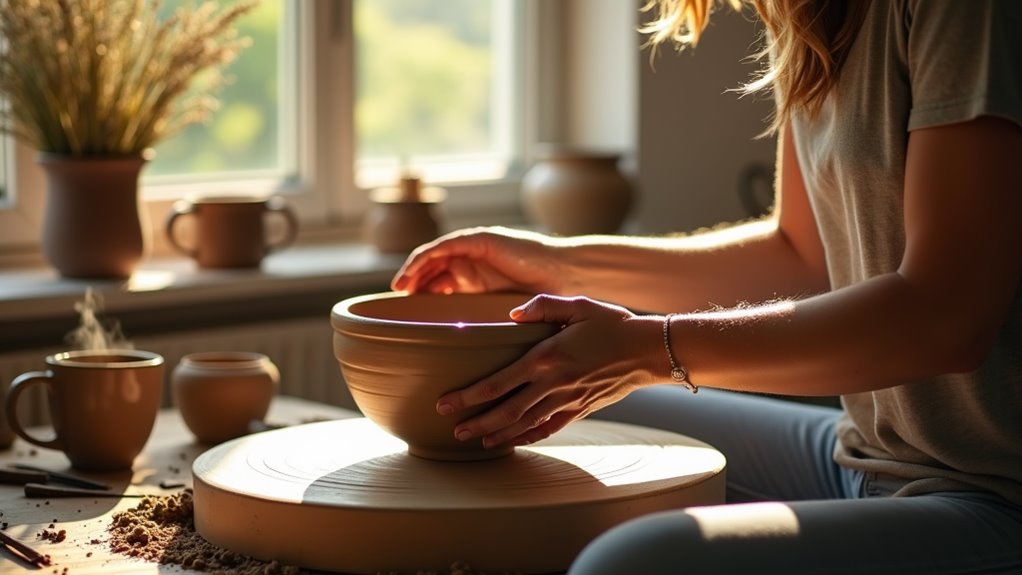
Developing your creative voice takes time and experimentation, but it's worth the journey.
Start by observing what draws you in – colors, textures, patterns, or themes that spark your interest. Notice which creators inspire you, but don't try to copy them exactly.
Try different techniques and materials until you find combinations that feel natural. You'll know you're on the right path when your work brings you joy and feels authentic.
Don't worry if your early attempts aren't perfect; each project teaches you something valuable about your preferences and style.
Trust your instincts when they tell you to break from convention. Your unique perspective is what makes your creations special.
As you practice and grow, you'll develop signature touches that make your work distinctly yours.
The Mindfulness of Making
When you create with your hands, you're practicing the art of being fully present in the moment.
Your focus naturally shifts to the tactile sensations and rhythmic movements as you work with materials and tools, creating a state of flow that quiets mental chatter.
Through the mindful practice of making things yourself, you'll discover a deeper awareness that extends beyond the creative process into other areas of your life.
Present Focus Practice
Mindfully engaging with each step of the making process can transform your DIY projects into meditative experiences. When you're crafting, focus on the sensations: the texture of yarn between your fingers, the rhythmic motion of kneading dough, or the earthy scent of freshly cut wood.
Notice how your breath naturally syncs with repetitive movements. You'll find that staying present helps you spot mistakes early and make better decisions about your work. Instead of rushing to finish, savor each moment of creation.
Let your mind settle into the flow of making rather than wandering to your to-do list or tomorrow's worries.
Try practicing this present-moment awareness with simple projects first. You'll develop both better crafting skills and a calmer mindset that extends beyond your workshop.
Flow Through Your Hands
The magic of handmade creation flows directly through your fingertips. When you're crafting something by hand, you'll feel a unique connection between your mind and the materials you're shaping. Each movement becomes deliberate, each touch purposeful, as you transform raw elements into something meaningful.
You'll notice how time seems to slow down when you're fully engaged in making. Your hands become instruments of meditation, whether you're kneading bread dough, molding clay, or weaving fiber. This tactile engagement grounds you in the present moment, allowing worries to fade as you focus on the sensations beneath your fingers.
This is mindfulness in its most practical form – the art of creating with presence, patience, and intention flowing through your hands.
Finding Deeper Awareness
Making things by hand opens a gateway to deeper self-awareness. When you engage in crafting, you'll notice subtle shifts in your consciousness as your mind settles into the rhythm of creation. Your breathing naturally slows, and your attention narrows to focus on the present moment.
Through handwork, you'll discover how your thoughts flow and where your mind tends to wander. You'll learn to recognize tension in your body and observe how different materials and techniques affect your state of being.
This heightened awareness extends beyond your crafting time, helping you become more attuned to your daily experiences. You'll start noticing patterns in your behavior, emotional responses, and decision-making processes. Creating with your hands becomes a form of moving meditation, teaching you about yourself with every stitch, stroke, or fold.
Building Community Through Craft
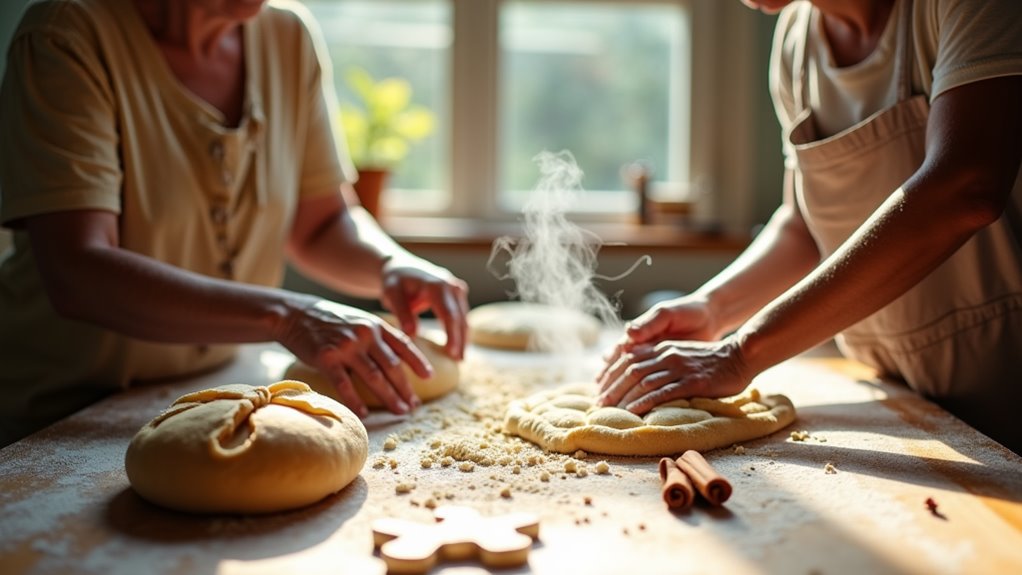
When you share crafting skills with others, you're building meaningful connections that extend far beyond the techniques themselves.
You'll find that teaching someone to knit, garden, or preserve food creates lasting bonds and mutual trust.
Whether you join a quilting circle, pottery class, or bread-making group, you're becoming part of a community that values both tradition and personal growth.
Shared Skills Build Connections
Learning traditional crafts creates meaningful bonds between generations and neighbors. When you share your expertise in knitting, woodworking, or canning, you're not just passing along practical skills – you're weaving connections that strengthen your community.
These exchanges often spark friendships that extend beyond the craft itself. You'll find that teaching others helps you master your own abilities while creating lasting relationships.
Whether you're showing a child how to bake bread or learning quilting from an elderly neighbor, these interactions build trust and understanding across age groups. As you exchange knowledge, you're also sharing stories, values, and cultural traditions.
The skills you learn and teach become threads in a larger social fabric, connecting you to both past and present members of your community.
Crafting Groups Foster Belonging
The simple act of joining a crafting group opens doors to genuine friendships and lasting connections.
When you gather with others who share your passion for creating, you'll discover conversations flow naturally as you work side by side on projects. Whether you're knitting, quilting, or crafting pottery, these shared experiences create bonds that extend beyond the craft room.
You'll find support and encouragement as you learn new techniques, celebrate achievements, and work through creative challenges together.
These gatherings become more than just skill-sharing sessions – they transform into vital social networks where you can be yourself. Your crafting circle might start as strangers brought together by common interests, but it often evolves into a trusted community where you'll find understanding, acceptance, and true belonging.
Passing Down Traditional Skills
Throughout history, families have shared vital knowledge and practical abilities across generations, keeping traditional skills alive through hands-on teaching and patient mentorship. When you learn traditional crafts from skilled relatives or mentors, you're not just mastering techniques – you're preserving cultural heritage.
You'll discover that learning skills like knitting, woodworking, or bread-making creates meaningful connections between past and present. As you practice these time-honored methods, you'll develop a deeper appreciation for the wisdom embedded in traditional practices.
Whether you're learning to can vegetables from your grandmother or teaching your child to sew, you're part of an unbroken chain of knowledge that stretches back centuries.
These skills become treasured gifts that you'll pass forward, enriching future generations with practical abilities and cultural understanding.
Sustainable Making for Tomorrow
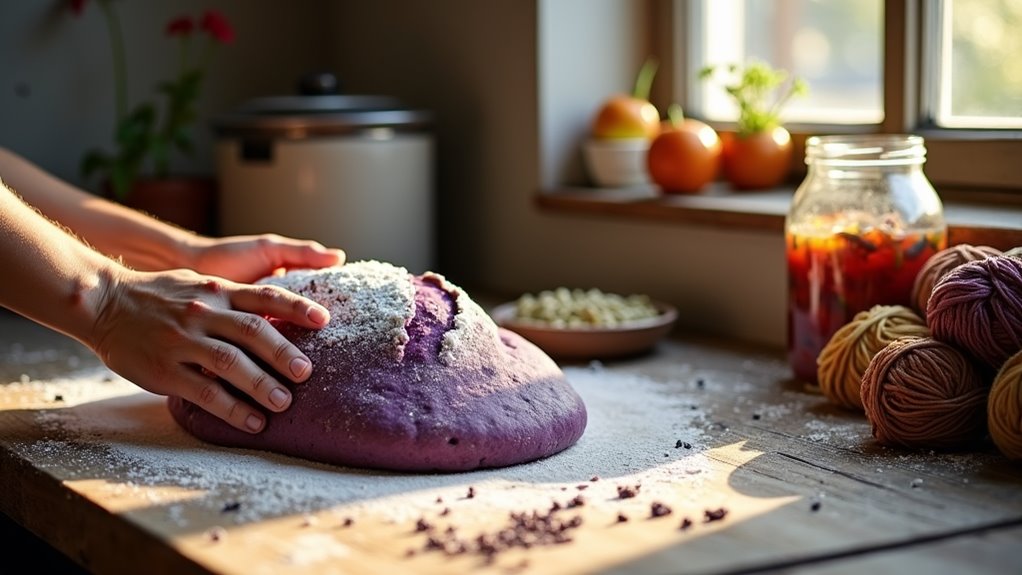
While traditional crafts honor the past, sustainable making focuses on protecting our planet's future.
You can embrace eco-friendly practices by choosing renewable materials, upcycling existing items, and minimizing waste in your creative projects. Consider using natural dyes, reclaimed wood, or organic fibers in your work.
You'll find that sustainable making often leads to innovative solutions. Transform glass bottles into unique lighting fixtures, convert old fabric into modern quilts, or create garden planters from salvaged materials.
When you source locally and choose biodegradable materials, you're reducing your carbon footprint while creating meaningful pieces.
Frequently Asked Questions
How Do I Price My Handmade Items Fairly for Both Maker and Buyer?
Calculate your material costs and multiply by 3-4 to cover overhead expenses.
Add your hourly rate (don't undervalue your time) multiplied by the hours spent creating.
Research similar items in your market to ensure competitive pricing.
You'll need to balance earning a fair wage while keeping prices reasonable for buyers.
Test different price points and adjust based on customer feedback and sales data.
Where Can I Find Authentic Vintage Materials and Supplies for Traditional Crafts?
You'll find genuine vintage crafting supplies at estate sales, flea markets, and antique shops in your area.
Check online marketplaces like Etsy's vintage section, eBay, and Ruby Lane for specific materials.
Don't overlook local thrift stores, yard sales, and architectural salvage yards.
Join crafting groups and online communities where collectors often trade or sell authentic supplies.
Your local historical society might also connect you with traditional craftspeople who've vintage materials.
What Insurance Do I Need When Selling Homemade Products?
You'll need several types of insurance when selling homemade products: product liability insurance to protect against customer claims, general liability insurance for business operations, and property insurance to cover your equipment and materials.
If you're working from home, check with your homeowner's insurance provider, as you may need additional coverage.
Consider business interruption insurance to protect your income if production stops unexpectedly.
How Do I Protect My Original Designs From Being Copied by Others?
Did you know that over 85% of design theft cases go unreported?
To protect your original designs, you'll need multiple layers of defense. Register your work with the U.S. Copyright Office, document your creative process thoroughly, and use watermarks on digital images.
Consider trademark registration for logos and brand elements. You can also add visible copyright notices and use non-disclosure agreements when working with manufacturers or partners.
Which Crafts Are Most Profitable for Turning Into a Home-Based Business?
You'll find that jewelry making, custom clothing, and digital art prints typically offer the highest profit margins for home-based craft businesses.
Handmade soaps, candles, and personalized wood items also sell well with lower startup costs.
If you're skilled at fiber arts, custom knit or crochet pieces command premium prices.
Consider your expertise and local market demand when choosing – what's profitable in one area mightn't work in another.
Conclusion
Like Prometheus gifting fire to humanity, you now hold the spark of creation in your hands. You've discovered that making isn't just about the finished product – it's about weaving yourself into the fabric of human tradition. As you craft, teach, and share your handmade legacy, you're keeping ancient wisdom alive while building tomorrow's sustainable future. Your creative spirit, once awakened, will never slumber again.
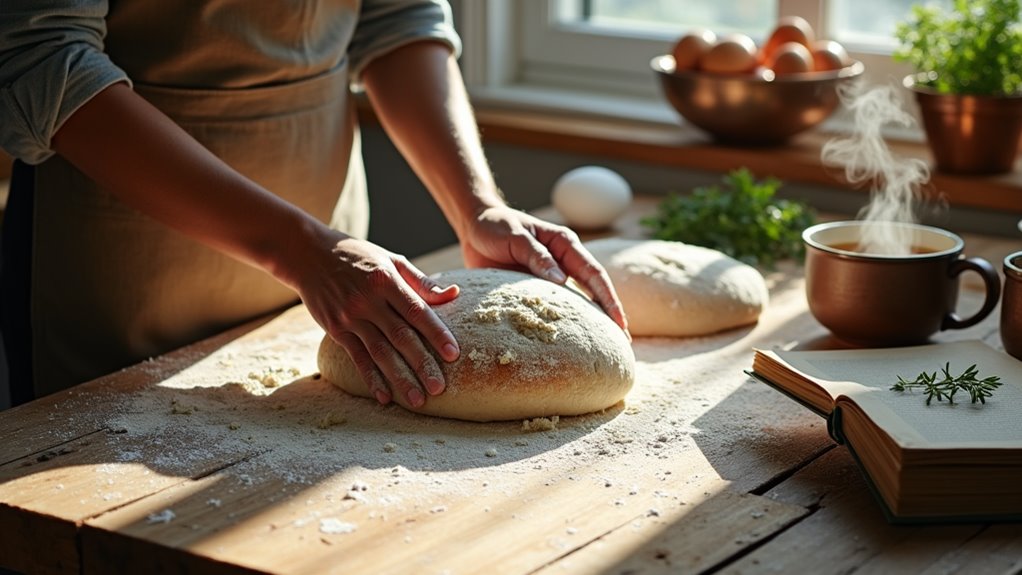
Leave a Reply